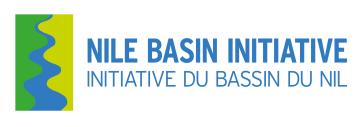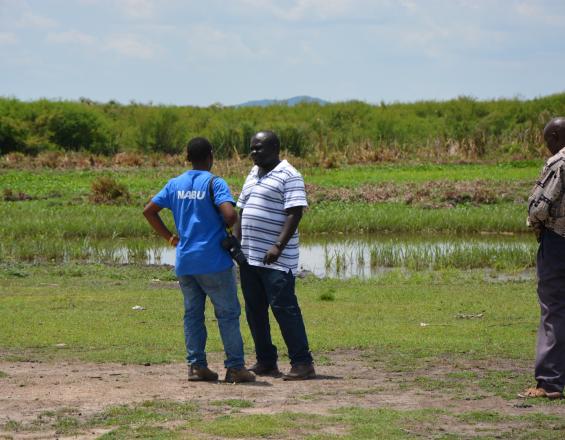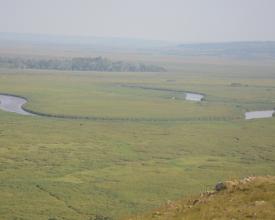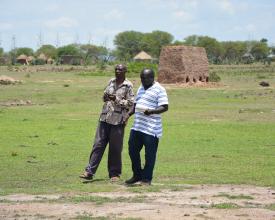
Nile River Basin transboundary wetlands conservation

The Nile River Basin is characterized by diverse transboundary wetlands that are crucial for local livelihoods. Our overarching approach is catchment-based water resources management at landscape level. Our solution involves several assessment activities to improve the knowledge base including participatory wetlands assessment, modelling and climate vulnerabilities appraisal for baseline information. In addition the solucion covers various planning and institutional strengthening activities such as strengthening transboundary stakeholders’ forae, transboundary wetlands integrated planning, wetlands zonation and restoration, catchment soil and water conservation. Furthermore, the livelihoods of communities are 'greened' through incentives-based conservation agreements models and working with nature-based approaches.
Context
Challenges addressed
The Nile River Basin transboundary wetlands are landscapes of high biodiversity and critical ecosystem goods and services (esp. water) that contribute to the socio-economic development and regional economies. For instance, Semliki sub-basin is a biodiversity hotspot including the Albertine Rift Region. This region is known for socio-economic activities such as tourism, agriculture and livestock keeping, fisheries and recently oil extractive industry. It is one of the climate change hotspots in the Nile Basin Region as indicated by melting and decline of ice in the Ruwenzori mountains. This combination of critical and competing land-use activities and climate change impacts provides a suitable landscape for employing the ecosystem-based adaptation approach. The Semliki sub-basin is equally critical for hydrology and ecology of the Nile river. The same characterization is true for Sio-Malaba-Malakisi, Mara and Akagera rivers landscapes and for the Sudd wetlands complex in South Sudan.
Location
Process
Summary of the process
The Nile Basin Transboundary Wetlands Conservation Solution has three building blocks namely;
- Building a knowledge base on transboundary wetlands for informed sectoral planning and mainstreaming (building block 1).
- Transboundary sub-basins wetlands integrated planning for strategic interventions and stakeholders involvement (building block 2).
- Capacity building and networking for empowered personnel and multiple stakeholders collaboration in transboundary wetlands conservation (building block 3).
The building blocks jointly interact in such a way that it avails information on wetlands status and associated biodiversity and ecosystem goods and services critical for livelihoods security and climate change adaptation. The information is used by stakeholders in integrated planning developing strategic interventions for implementation and associated institutional, community and personnel capacities built through training and networking.
Building Blocks
Building of a knowledge base on Nile River Basin transboundary wetlands
This building block is to avail critical information on transboundary wetlands for informed action. The information being gathered includes wetlands status and extend, prevailing biodiversity, wetlands ecosystem services and contribution to regional economies, wetlands potential in carbon sequestration, wetlands potential as green infrastructure and wetlands potential in climate change adaptation. Nile Basin Initiative and its partners have done and continue to undertake vulnerability assessments. One example is the hotspot methodology (UNEP 2013) to identify key ecosystems or regions that may be especially vulnerable to climate change. The hotspots were identified using 10 selection criteria: water shortages, availability of surface water sources, groundwater shortages, environmental degradation, population dependency, ecosystem dependency, groundwater regime, mean annual rainfall, socioeconomic benefit and contribution to the sustainability of the Nile Basin. Six hotspot areas identified as a result of this exercise—the Nile delta, Nile Valley, Ethiopian plateau, Nile confluence, the Sudd wetlands and Mt. Ruwenzori. Additionally, climate information services are provided for climate proofing of infrastructure investments.
Enabling factors
The building of knowledge base will be successful if the information is packaged well for use by decision-makers and if there is trained personnel to tap on the availed information. Working on transboundary wetlands requires transboundary agreements and organizational structures. The Nile Basin Initiative has established and continues to develop joint transboundary wetland management plans, transboundary wetlands committees and working groups.
Lesson learned
Gathering information especially on large scale is expensive. Generation of information must be supported by a clear roadmap on how the generated information will be availed to decision-makers for informed planning and action. Existence of trained personnel to tap into the information is key. The Nile Basin Initiative involves state parties through relevant ministries hence generation of information and its implementation has automatic legitimacy and political goodwill.
Transboundary integrated wetland plans
Transboundary wetlands integrated planning is ongoing and aims at developing a road map for wise use of transboundary wetlands for ecological integrity and livelihoods climate resilience. The transboundary wetlands integrated plans involve specific transboundary wetlands inventories, stakeholders mapping, wetlands ecological and socio-economic challenges, strategic goals and interventions and action planning and costing and development of multi-stakeholder implementation plan and associated transboundary governance structure. Additionally, EbA related interventions such as riparian areas protection, watershed soil and water conservation, water sources protection and landscape greening are captured. The stepwise process includes 1) Description of site features, 2) Evaluation of features and selection of key features, 3) Formulation of long-term objectives for each key feature and 4) Formulation of short-term operational objectives for each key feature. In the case of Sio-Siteko wetlands (Kenya, Uganda), a discussion forum helped to identify key issues among stakeholders and their vision. Management objectives therefore focus on the values and interests of the stakeholders rather than exclusively on the ecological values.
Enabling factors
Enabling conditions include transboundary governance structures, political goodwill from countries involved and financing of the plan.
Lesson learned
Transboundary wetlands integrated plans must be anchored on joint envisioning by the countries involved, joint transboundary governance structures to ensure peer review and success from parties involved. Sustainable financing of the plan is key as experienced in Sio-Siteko transboundary wetlands plan.
Capacity development and networking for transboundary wetlands resilience
The purpose of this building block is to train wetlands institutions and personnel on contemporary wetlands conservation skills, knowledge, tools, methods and approaches to be able to deliver on Nile River Basin transboundary wetlands conservation effectively and efficiently. The capacity building approach involves both online or virtual training, on-site learning exchanges, field-based training, thematic face-to-face modules workshop methods and learning forums. It covers themes such as wetlands and livelihoods, wetlands and climate change adaptation, wetlands management planning, environmental flow assessments and wetlands valuation. Stakeholders include Nile Basin state parties, wetlands communities and non-state actors. It also involves networking of state and non-state actors working on Nile River Basin wetlands for coordinated endeavors devoid of duplication and securing of desired critical mass for greater impact. Finally, it involves communication outreaches through multiple media on imperative of Nile Basin wetlands and associated biodiversity and ecosystem services.
Enabling factors
Undertaking training needs assessment for demand driven training modules and participatory and inclusive stakeholders’ platform for proactive stakeholders’ network.
Lesson learned
The need to ensure training modules are demand driven and establishment of inclusive stakeholders’ network platform form productive stakeholders’ engagement.
Impacts
- Environmental impacts: Our solution implementation is ongoing and impacts include restored wetlands for biodiversity conservation, carbon sequestration and amelioration of ecosystem services such as floods control through wetlands water storage and droughts buffering through water release for domestic and livestock consumption.
- Economic impacts: Enhancement of livelihoods climate resilience; fisheries, livestock and farming through wetlands restoration ensuring quality water supply, soil conservation and fish breeding areas protection.
- Social impacts: Functional transboundary wetlands integrated plan and baseline information enable informed, coordinated interventions and stakeholder engagement. Additionally, training and capacity building on mainstreaming of wetlands in sectoral development planning contribute to enhanced sustainability.
Beneficiaries
The direct beneficiaries include wetlands resource users such as farmers, livestock keepers and fisher folk. Other beneficiaries include tourism, traders and consumers of goods and services derived from this landscape.
Sustainable Development Goals
Story

The Nile basin transboundary wetlands are very imperative for biodiversity conservation, climate change adaptation, livelihoods security and provision of ecosystem goods and services critical for the economies of the Nile basin region. Sio-Malaba-Malakisi sub-basin is characterized by multiple wetlands including the transboundary wetlands of Sio-Siteko supplied by river Sio waters originating from Mt Elgon. It is shared by Kenya and Uganda and discharges its waters in Lake Victoria. Sio-Siteko Transboundary Wetlands Plan is a living document developed for two years by state and non-state actors in Uganda and Kenya for the sustainable utilization and conservation of Sio-Siteko transboundary wetlands. It details a vision and road map of Uganda and Kenya communities and other stakeholders in working together to secure their wetlands for ecological integrity, climate change adaptation and livelihoods resilience. The wetland provides benefits to the community such as water supply, fisheries and farming, among others. The community wetlands committees in Kenya and Uganda - created as a result of integrated wetlands planning - are inspired and are undertaking local actions towards wetlands conservation and climate change adaptation which include: wetlands zonation and restoration, wetlands conservation education and awareness, alternative livelihoods promotion and outreaching other stakeholders and supporters armed with integrated wetlands plan for support in delivery prioritized interventions in the plan. Thus it helps them adapt to extreme weather events such as floods and droughts in their agricultural based livelihoods of crop farming and livestock keeping and diversification by fishing.







